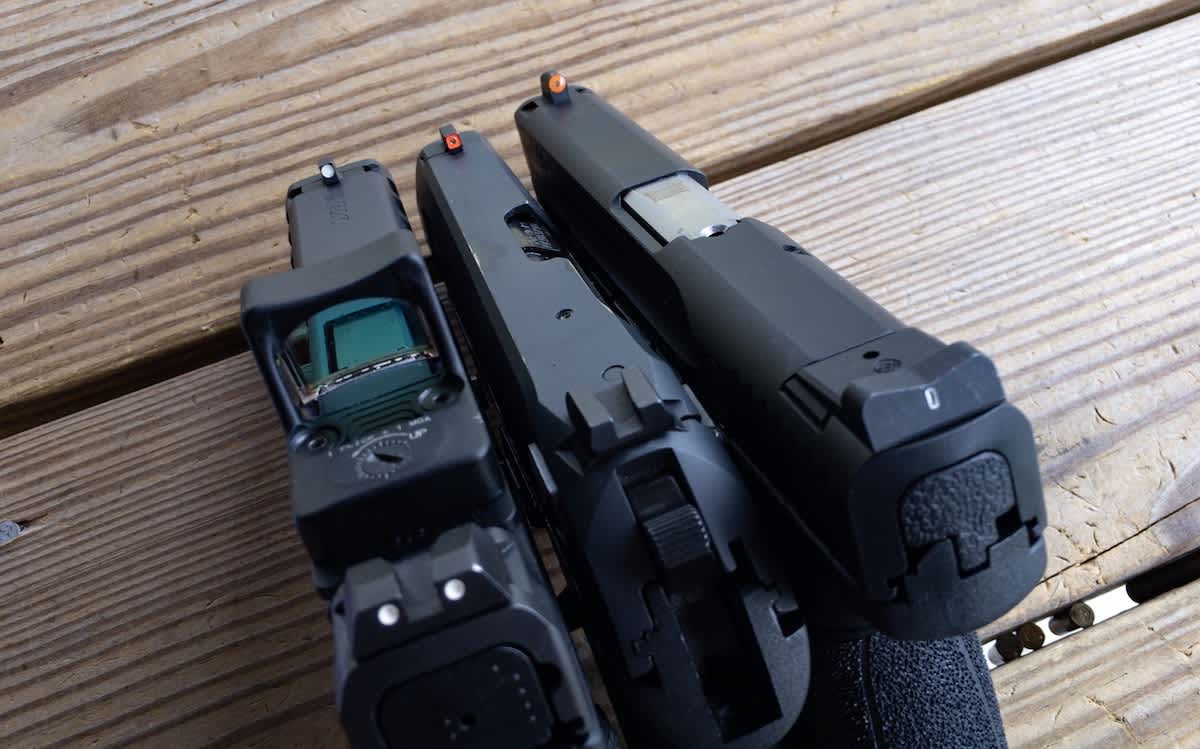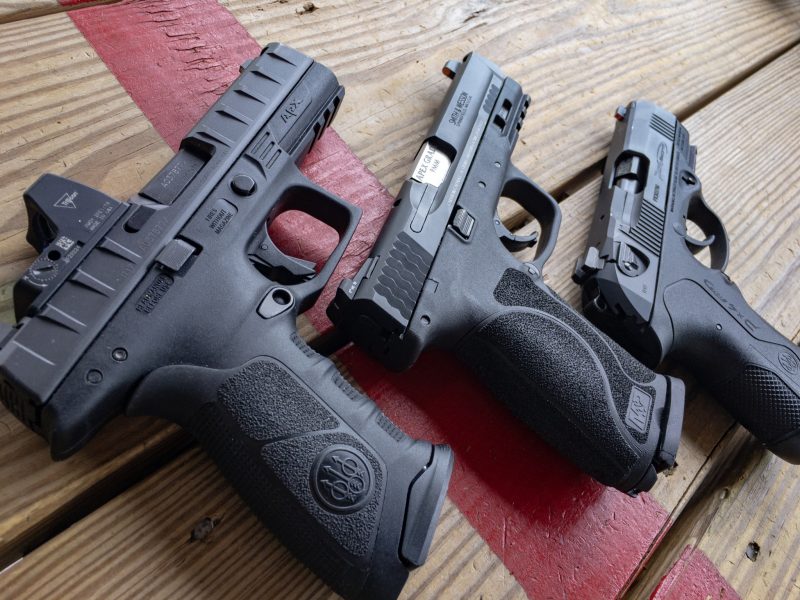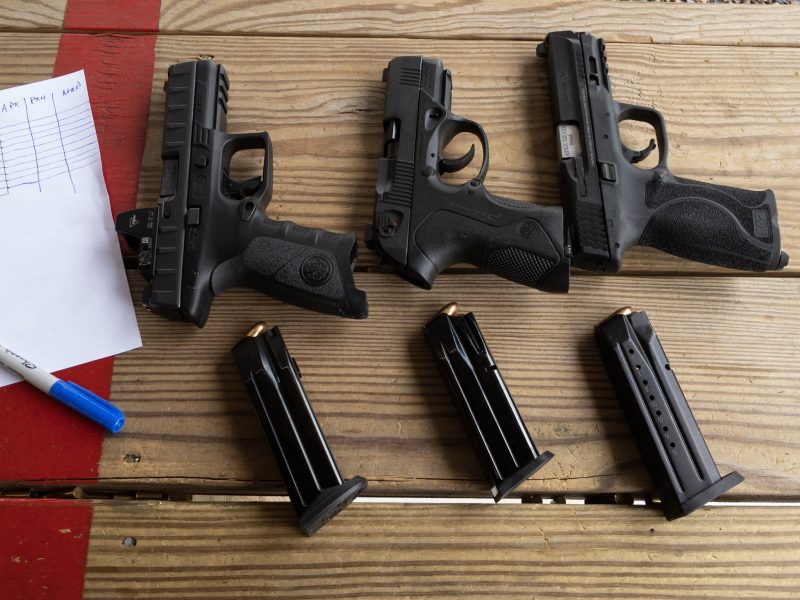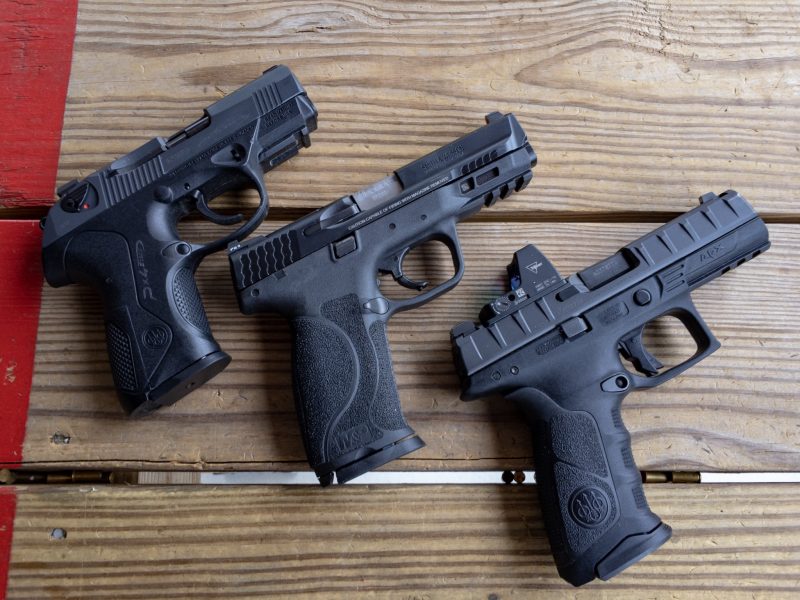Will Standard Pistol Sights Ever Change?
Tom McHale 04.10.19

When it comes to smartphones, no one blinks when new models violate tradition and the “old way” or doing things. So, when we hear that the new iDroid X++ will inject cranial microchips so you can thought control those Angry Bird slingshots, our response is, “Cool! That sounds like a handy feature, I can’t wait to toss my old phone and drop $4,500 on a new one!”
When it comes to guns, things move a little slower. I figure it takes a century or so for innovative ideas to become mainstream. For example, I know for a fact that optics were invented a long, long time ago because guys like Galileo used them. What took forever was for shooters to accept the idea that it might be a good idea to mount an optic with glass parts (!) on a rifle to make aiming easier and more precise.

As for handguns, we’re still in a holding pattern, although there are signs of new technology adoption. By my count, 98.34 percent of handguns currently in circulation use traditional notch and post iron sights. OK, so maybe I didn’t count them all, but a glance at any shooting range line will tell you that newer sighting solutions are still relatively few and far between. You’ll see a red dot sight here and there and maybe some variations on the traditional three-dot and notch and post sights, but by no means are any of those alternative solutions mainstream – yet.
I tend to think that we’re not far away from a time when the “normal” configuration for a carry pistol will include a red dot sight. Just like crotchety old cowpokes and saloon residents back in the day when rifle scopes were fragile, unreliable, and always having the batteries run out, the pistol optics naysayers are running out of excuses today. Modern pistol optics are more durable than ever, light, compact, and run for 75% of forever on a single battery change.
And that’s not all. Companies like XS Sights have been tooting the “consider some new ideas” horn for years. The introduction of their Big Dot sights years ago found a loyal fan following – and a bunch of naysayers. The idea behind the Big Dot concept, much like the sighting systems of those cowboy lever-action rifles, was to provide a fast, intuitive, and precise enough system for defensive work. More recently, the company has announced its DXT2 Big Dots which do an even better job of providing high-contrast sight pictures in all light conditions.
One thing I’ve noticed about people is that we tend to make lots of generalizations. Pick a topic and we’ll have a very strong opinion, well before qualifying the surrounding circumstances. Such as it is with handgun sights. People will poo-poo alternative ideas like optics and red dots for all kinds of reasons without even considering the purpose for which one might want those particular features. For example, the big knock on XS Big Dots was that they aren’t precise enough to do things like make headshots on running ax murderers at ranges past 250 yards. OK, I exaggerate, but you get the idea. These sights exist for defensive use. Ipso facto e. pluribus unum, they’re designed to get shots on a reasonably-sized target as fast as possible. While you can make surprisingly precise shots with them, that’s not their primary raison d’être.
My primary interest in handgun shooting is carry and home defense. Sure, I enjoy plinking too, but when I choose features, defensive use attributes get the top consideration spot. With that said, I’ve been contemplating changing my long-term carry gun sighting configuration. All I’ve ever carried are pistols with standard notch and post sights. However, I’ve got a couple of guns in house that provide new things to try: red dot sights and those new XS DXT2 Big Dots.

To test out suitability, I did some initial side-by-side evaluation to compare both of these newfangled options to my current carry setup. To introduce a little quantifiable measurement into the process, I set up the new 2019 FBI Qualification Course in triplicate and shot through it with three different pistol and sight configurations:
Beretta PX4 Compact Carry
This semi-custom Beretta PX4 model is optimized for carry and includes night sights with an enlarged day-glow orange dot on the front sight with a Tritium vial in the center. These sights are as visible as any I’ve ever used, so I figured this setup would provide the best possible data for the iron sight configuration.
Smith & Wesson M&P 2.0
I upgraded the barrel on this one with a semi-drop-in Apex Tactical replacement, so now it’s a one inch and change tack driver for five shot groups at 25 yards. This was the pistol on which I installed the new XS DXT2 Big Dot sights.
Beretta APX RDO
This full-size Beretta APX comes ready for a red dot sight installation. By choosing the correct mounting plate, you can mount a variety of pistol red dot sights. I installed a Trijicon RMR. While this sight has a smaller window that many others, it’s built like a tank and offers the big defensive use benefit of “always on” operation. The battery lasts for years. I don’t know how many because I just change it every New Year’s day and forget about it. No, on this pistol with my annual power source change, the battery won’t run out at the worst possible time.

So, with three pistols, each with a different sighting system, and three targets, I shot the following course of fire.
FBI 2019 Pistol Qualification
| Distance (yards) | Starting Position | Shots | Time (seconds) | Notes |
| 3 | Draw | 6 | 6 | Fire 3 strong hand, switch hands, fire 3 weak hand. |
| 5 | Draw | 3 | 3 | Draw and fire 3 shots in 3 seconds. |
| 5 | Ready | 3 | 2 | From the low ready position, aim and fire 3 shots in 2 seconds. |
| 5 | Ready | 6 | 4 | From the low ready position, aim and fire 6 shots in 4 seconds. |
| 7 | Draw | 5 | 5 | Draw and fire 5 shots in 5 seconds. |
| 7 | Ready | 8 | 8 | Fire 4 shots, reload, fire 4 more shots. |
| 7 | Ready | 5 | 4 | From the low ready, aim and fire 5 shots in 4 seconds. |
| 15 | Draw | 3 | 6 | Draw and fire 3 shots in 6 seconds. |
| 15 | Ready | 3 | 5 | From the low ready, aim and fire 3 shots in 5 seconds. |
| 25 | Draw | 8 | 20 | Fire 4 shots, drop to kneeling, fire 4 more shots. |
| Total | 50 | 63 |
The Results?
Perhaps surprisingly, I shot the course with less effort with both of the “new” pistol configurations than with one of my everyday carry setups. The times in the new FBI course aren’t aggressive, but they do prohibit slow and methodical aiming for each shot except for the final 25-yard stage. You have an eternity to complete that one. That’s just what I wanted for this type of test. I was hoping to get a feel as to whether any of these new and different sighting methods would have the potential to increase my speed and combat accuracy. “Combat accuracy” is the important factor here. For a carry gun, I don’t care about shooting two-inch groups at 25 yards at a pace of five seconds per shot. I care about seeing sights quickly, getting them aligned with the target, and getting shots to land where I want as fast as possible.
Shooting the red dot-equipped Beretta APX, I had no trouble keeping shots on target at all ranges from three to 25 yards. Having shot red dot pistols recreationally a fair bit, I was accustomed to the sighting system although I had never run through a qualification course using them. The trick is to forget about the red dot sight as you raise the pistol. Just look for the front sight as normal and the dot will be in your field of view. Where things get weird, and slow, is when you start to look for the dot. Then it hides from you.
Anyway, the net-net of this configuration was that accuracy was easy. When the eye only has one focal point (the dot) that appears to be superimposed on the target, there is nothing to line up. You don’t have to concentrate on the front sight. You don’t have to line that up with the rear sight. And you don’t have to line both of those up with the target. It’s a very intuitive and natural system. It’s also forgiving, as it still works even if your eyeball is not perfectly lined up with the line of the bore. If you can see the dot, and if it’s on target, you’re going to get a hit. Perhaps not surprisingly, the smallest overall group of all 50 shots in the qualification came from this setup. Where it really shines is at the longer distances of 15 and 25 yards in the course.

The XS Big Dot configuration was a surprise to me. I’ve shot the older versions here and there over the years, but I’ve never trained thoroughly with Big Dot sights. After my first shot of the day with the Big Dots, which was a miss just outside of the target boundary line, it was easy to get hits, fast, on the center mass of the silhouette target. The dot was impossible to miss and was the fastest of all three setups to acquire. The big surprise was that I got the second best overall 50-shot group with the Big Dot sights. After hearing how they’re not “precise” from the haters, I was prepared for more variance on target. Not so. Put the dot on the target, execute a smooth trigger press, and you get success. I really like these sights and will be working with them more over the next couple of weeks to see if they’ll find a place on my daily carry gun.

We’re all reluctant to change, especially with something that has life and death consequences like a self-defense handgun. However, the world continues to turn, and sooner or later, enterprising companies and people are going to come up with better solutions. We’re slow to adopt new things, and should be, but I think the time is here to start looking at new and improved sighting options.

